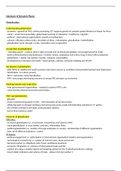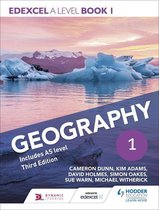Summary of Dynamic Places
Globalisation
Understanding globalisation
- economic = growth of TNCs, online purchasing, ICT supports growth of complex spatial divisions of labour for firms
- social = social interconnectivity, global improvements in education + healthcare, migrants
- political = international organisations, growth of trading blocs
- cultural = Western culture traits, circulation of ideas + information, glocalisation + hybridisation
- globalisation works through = trade, colonialism and co-operation
Acceleration of globalisation
- ‘’shrinking world’’ = reduces time it takes to trade and communicate globally, encouraged growth in trade
- quick communications help businesses = transfer money, employees and orders, keep in touch with production,
- global flows = capital, information, tourists, migrants, commodities
- developments in transport and trade = steam power, railways, container shipping, jet aircraft
Key players in globalisation
- after WW2 to stabilise the world economy and avoid a return to conditions that prevailed during Great Depression
- World Bank = to reduce poverty
- WTO = advocates trade liberalisation
- IMF = encourages developing countries to accept FDI and open up economies
Working outside main trade blocs
- inter-governmental organisations - needed to achieve WTO’s aim
- some develop informal economic partnerships
TNC’s and globalisation
- glocalise
- locate manufacturing plants in SEZs – will eventually sell products there
- offshoring parts to cheaper locations and outsourcing parts usually administration and data to 3 rd parties
- use of faster transport and rapid communication systems
- just-in-time business model
Measures of globalisation
KOF Index
- economic globalisation i.e. cross border, transactions and volume of FDI
- social globalisation i.e. cross border contracts, information flows
- political globalisation i.e. number of foreign embassies in country, membership of different organisations
- each set of different indicators = scaled
AT Kearny
- political engagement i.e. participation in international organisations treaties and organisations
- technological connectivity i.e. number of internet users, hosts and servers
- personal contact i.e. telephone calls, travel, remittance payments
- economic integration i.e. volumes of international trade and FDI
- worked out using a complex points and weighing system for the 4 individual indicator rankings
- more holistic indicators and volume of trade – allows US to be number 3
, Switched on and switched off worlds
- global cores best placed to specialise and produce goods – moved by demographic, finance and trade flows
- global core-periphery model – offshoring + outsourcing come from core, downward transition areas lose out to FDI
- as countries globalise, certain characteristics change: flows, technologies, movements and media
- economic, environmental, political, social and physical isolation
Global shift
- outsourcing and offshoring of industry through FDI
- 3 factors accelerated global shift = individual Asian countries began to allow overseas companies to access markets,
TNC’s began to seek new areas for manufacturing + outsourcing services, FDI began to flow into the emerging Asian
countries
- impacts on LICs = biodiversity loss, education, poverty reduction, low wages, lack of union, loss of tradition
- impacts on HICs = inner city spiral deprivation, depopulation, development of new technology, dereliction
Growth of mega cities
- 60% of growth due to rural-urban migration
- 40% of growth due to high birth rates (natural increase)
- urban pull = nightlife, school + healthcare, govt security, offer promotion + advancement into professional roles
- rural push = seasonal employment, crop failure, wars, agricultural modernisation reduces need for rural labour
- shrinking world technology ‘’switch on’’ people in remote and impoverished areas
- social challenges = lack of clean water, private companies who invest target high earners first, short supply of homes
- environmental challenges = sprawling slums at city edge, rivers + lakes polluted, air pollution
Global interconnections and rapid urbanisation trends
- global hub = highly-globally connected city that has natural resources i.e. coastline and human resources i.e. labour –
found at countries with varying levels of development, growth due to elite, low waged and internal migrants
- low waged migrants = help infrastructure, entry visas tied to specific jobs, cheap flow of labour
- elite migrants = help knowledge economy, investments made
- host locations = skilled workers to fill skill gaps, tensions, pressure on services, some host members cannot get jobs
- source locations = loss of skilled (brain drain), remittances boost income, closure of services, dependent population
- rural-urban migration uncommon in HICs – rural areas have changed
- challenges facing megacities – transport, food + water supply, urban employment, healthcare + education
Rise of a global culture
- cultural diffusion = spread of cultural change
- can happen through force, cultural imperialism (hard power) i.e. spread around world using force or soft power i.e.
shape global culture through their influence over global media
- Westernisation – joint role played by European and North American countries in bringing about global cultural change
– i.e. changed people’s diets, more people are speaking English
- global media coverage of Paralympics, Gay Pride marches etc may erode discrimination and prejudice
Cultural erosion
- migration, improvements in communications and global marketing cause cultural erosion - people no longer confined
to developing an identity based on the place they live
- developed countries are better equipped to protect its cultural heritage than developing world
- social impacts = learn new languages, languages become extinct, loss of tradition, indigenous people hunt endangered
species for food or to sell
- economic impacts = privatisation, people from tribes can work in farming, TNCs can provide useful skills for locals





